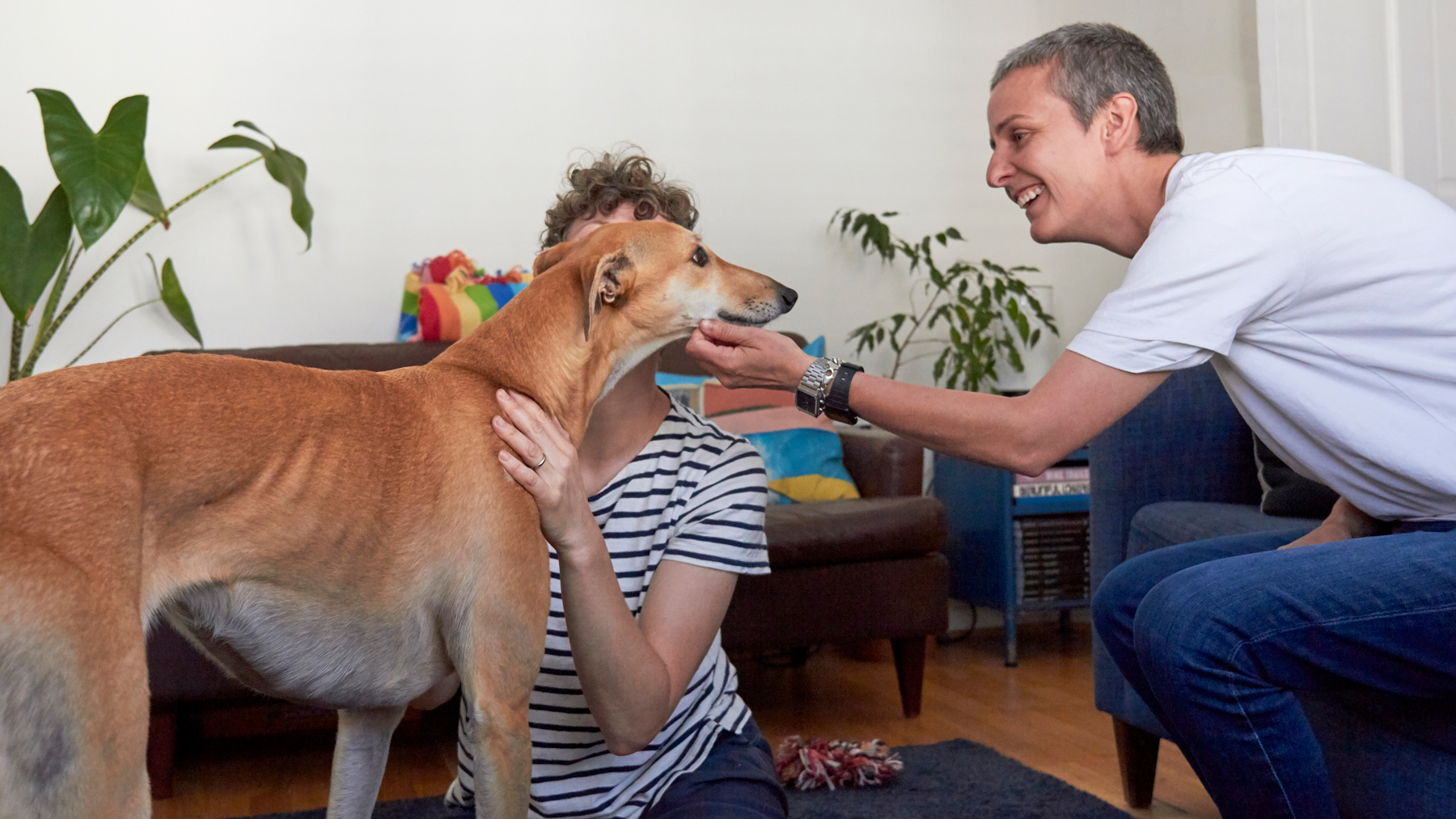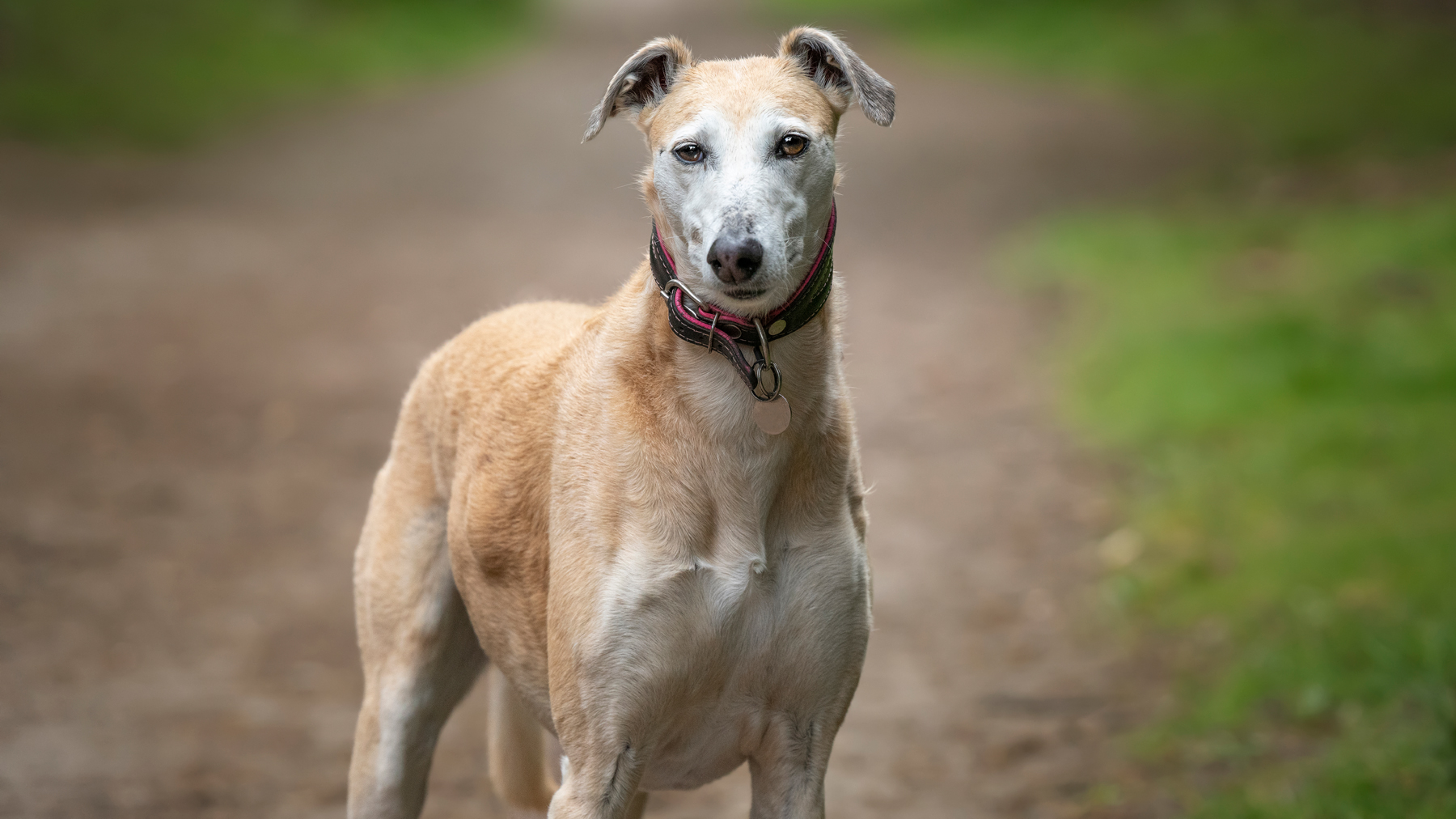
Adopting an adult dog can come with its own unique set of challenges, but when that dog is particularly nervous or struggles with anxiety, you may find yourself at the bottom of a metaphorical mountain as your dog deals with a new home, routine and primary person all at once.
I adopted a lurcher called Dixie a month ago and quickly discovered that she had a lot of worries that we were going to have to contend with. My kitchen floor which is made from stone terrified her (I assume because it felt funny on her paws), strange dogs sent her into a frenzy of barking and every noise was a cause for great concern in her lurcher brain.
I’m pleased to say that despite her nervousness, Dixie has settled in beautifully now and I’ve worked hard to build a relationship with her based on trust and safety.
Now I understand just how tricky navigating anxiety in dogs can be, I have formulated a list of nine things I did to help her settle in and overcome her worries. You will also see I have addressed some areas I think I should have worked on in hindsight, with input from an expert dog behaviorist and vet.
Nine things I did to settle my nervous rescue dog
1. Routine, routine, routine
My first priority when I brought Dixie home was to get her settled into a predictable routine, so there were as few unexpected elements to her day as possible.
Barking Heads dog behaviorist Adem Fehmi told me that you should base your new dog’s life around a set structure to help them settle: “Just like us humans, dogs can and will get bored and need regular mental and physical enrichment,” said Fehmi. “Without this type of enrichment, stress and anxiety can be exacerbated. Daily use of play toys, food dispensing toys and training can assist here.”
I also spoke to Emma Chandley BVetMed PGCertSAS MRCVS, a practicing vet and representative for Perfect Pet Insurance, who agreed that routine should be a priority with any new dog. “From the instant your dog steps foot in the door it is important to establish a routine and stick to it,” she said.
“This will allow your dog to adjust to their new way of life and also allow them to learn what to expect and when. This will help with anxious or stressed dogs. If they have a scenario where they are able to predict what is happening next, it will reduce the anxiety around the situation.”
2. Regular exercise
As Dixie is a lurcher - a type of sighthound - she ideally needs to be able to run in short bursts, so I took her out morning and evening to let her burn off any excess energy and give her some mental stimulation.
“This is beneficial for all dogs, but particularly if your dog is prone to suffering from stress, anxiety or a low mood in general,” explained Fehmi. “Constructively exercising your dog will help to drain some of your dog’s energy, energy that they might otherwise put into worrying and stressing at things out of their control.
“A well exercised dog is also more likely to settle and relax peacefully rather than one who is raring to go! Similar to the benefits that exercise has on us as humans, exercise has a positive effect on the mental wellbeing of our dogs and can help to keep them calm and well balanced.”
Regular exercise can be difficult to achieve if you’ve got an unvaccinated dog or a dog that needs to be quarantined, but if you have an enclosed outdoor space, you may be able to overcome this with set play times.
3. Create a calm, safe space for your dog
Thankfully, Dixie came with all her worldly possessions, so I quickly set her up with her bed and blanket in a corner that she could retreat to and watch me go about my day without having to directly interact with me unless she wanted to.
Chandley agreed that a safe haven is vital to helping your new dog settle in. “To allow your dog to adjust to their new home, ensure they have a safe area they can retreat to at any time where they can feel safe and secure and where they will be left alone,” she said.
“This could be a corner of a room with a bed in or an open crate. It should be away from the main flow of traffic through the house where they won't be disturbed for as long as they choose to stay there.” You can furnish this safe space with toys and longest lasting dog chews so that your dog can entertain themselves in their private space if they would like to.
“Playing classical or soft music can help your dog to relax and can help to reduce stress,” added Fehmi. “Classic FM is always a winner in my house! Music can also help to drown out any external noises that might otherwise cause your dog to worry and become stressed, contributing to a low mood. A nice comfortable and inviting bed can also help your dog to relax.”

4. Try to prepare your dog for any changes
This is an area I tripped over a bit. Dixie’s nerves made it difficult to introduce her to new things slowly, as she would generally opt out until it was completely necessary to do the thing. For instance, initially, we did the same walks every day, and when I tried to take her on an alternative route she would plant her feet and refuse to go.
Being a softie, I dismissed this and said: “That’s ok, we’ll try again tomorrow.” Unfortunately, the day came when she needed to be taken to the vet and we had to walk a different route to those she knew. Instead of just the new experience of going to the vet, we also had the new experience of walking a route she didn’t know, which left her feeling very nervous. It was a bad day for both of us.
“If you know that a change of routine is coming that might cause your dog to feel stressed then start preparing them for this in advance. Introduce them to people, objects, experiences and so on that will be part of their new routine, even if this will only be the case for a short while,” advises Fehmi. “The more flexible and confident your dog is in general, the easier it will be for them to cope with any change, reducing the potential for stress, anxiety and low mood to affect your dog.”
5. Try to understand your dog’s triggers
Dixie is a very communicative dog, so it was easy to figure out her triggers in most instances - loud noises, cats, the hoover; all understandable things to be afraid of. However, she came with some worries that I couldn’t wrap my head around to begin with, such as a terrible fear of zebra crossings (go figure). We got over this eventually with lots of the best dog treats and encouragement, but to begin with I was baffled.
Chandley encourages limiting exposure to any triggers to begin with, until you feel your dog is ready to tackle them. “Try where possible to reduce the exposure to environmental triggers that will evoke a fear response. This could be the doorbell ringing, car horns, loud music, or appliances in the house starting up. Pay close attention to your dog to see what sort of noises they react to,” she said. “If at all possible limit their exposure to these noises so they aren't in a constant state of alert.”
“Take steps to work through these so that, in time, they are not stressful for your dog,” advises Fehmi. “We want our dogs to learn about the world in a positive light and become confident individuals within it. A certified behaviorist can help you to achieve this should you need some support.”
6. Don’t smother your dog
While it may be tempting to shower your new best pal with cuddles and kisses, this is likely to be overwhelming for them, particularly if they have problems with nervousness.
“Don't try to pet your dog or force any physical contact. Sensitive places to avoid touching include their paws, anywhere on the head or the tail. Don't approach them from behind and avoid hovering over them to pick them up. It is best to let any physical contact be initiated by them,” said Chandley.
Dixe was particularly irritated by any attempts to touch her paws, which she got over with time, but caused problems to begin with as she desperately needed her nails trimmed. Most dog owners will agree that mastering how to clip a dog’s nails is no easy feat.
7. Let your dog set the pace
Dixie has settled in nicely now, but I really had to back off and let her take the lead, only doing what was within her comfort levels, which grew each day.
“If your dog is nervous and unsure about their new circumstances, initially you will be a big part of this. Give your dog space to get used to you being present, but not presenting any sort of threat,” advised Chandley. “Do not force any interactions or make them sit close to you. Make sure they have a comfortable place to retreat to, away from you but still within eyesight. Do not approach them or interact with them when they are in this place.”
Ultimately, the biggest thing your dog will need is time. Within three weeks, Dixie had gone from a very worried dog afraid of the kitchen floor, zebra crossings, and her water bowl (which came with her from her previous home and just became scary in a new environment) to a very relaxed dog who has a few worries we’re still working on.
Considering how skittish she was to begin with, I’m impressed with how quickly she’s adapted to her new home, me, and a new routine. We worked hard to build a foundation of trust, so now when she has a worry, she knows she can look to me for reassurance and as a point of reference.







